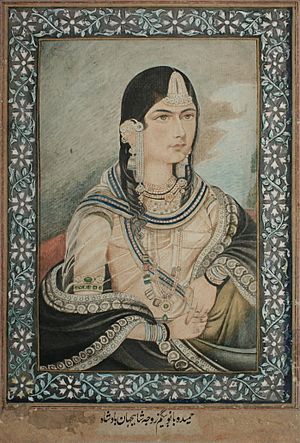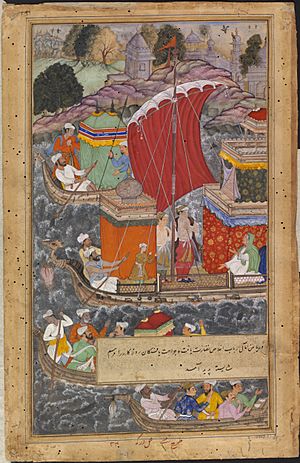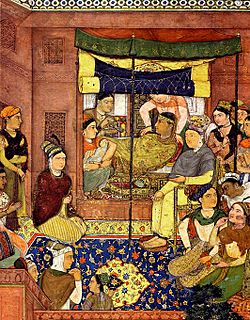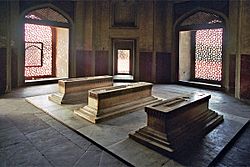Hamida Banu Begum facts for kids
Quick facts for kids Hamida Banu Begum |
|
|---|---|
| Queen consort of the Mughal Empire Queen mother of the Mughal Empire |
|

Artistic portrait of Hamida Banu Begum
|
|
| Padshah Begum | |
| Predecessor | Bega Begum |
| Successor | Saliha Banu Begum |
| Born | c. 1527 |
| Died | 29 August 1604 (aged 76–77) Agra, Mughal Empire (present-day India) |
| Burial | 30 August 1604 Humayun's Tomb, Delhi |
| Spouse | |
| Issue | Akbar Two daughters |
| Father | Shaikh Ali Akbar Jami |
| Mother | Mah Afroz Begum |
| Religion | Shia Islam |
Hamida Banu Begum (around 1527 – August 29, 1604) was a very important queen. She was the wife of Humayun, the second Mughal emperor. She was also the mother of Akbar, who became the third and one of the greatest Mughal emperors. Her son Akbar gave her the special title of Mariam Makani, which means "Dwelling with Mary". This showed how much he respected her. She was also known as Padshah Begum during Akbar's rule.
Contents
Her Family Background
Hamida Banu Begum was born around 1527. Her family came from Persia, which is modern-day Iran. Her father was Shaikh Ali Akbar Jami. He was a teacher to Prince Hindal Mirza, who was Humayun's youngest brother. Her father was also known as Mian Baba Dost. Hamida Banu's mother was Maah Afroz Begum. Hamida was a very religious Muslim.
How She Met Humayun
Hamida Banu Begum was about 14 years old when she met Emperor Humayun. This happened at a party given by Humayun's stepmother, Dildar Begum. Humayun was living in Alwar at the time. He was in exile because Sher Shah Suri had taken over Delhi. Sher Shah Suri wanted to bring back Afghan rule.
When Humayun wanted to marry Hamida, she and Prince Hindal were against it. Hamida did not want to meet the emperor at first. But after 40 days, and with Dildar Begum's help, she finally agreed to marry him.
Her Marriage and Motherhood

The wedding happened in September 1541, in a place called Paat in Sindh. Humayun chose the day using his knowledge of astrology. Hamida became his second wife. His first wife and chief queen was Bega Begum. This marriage was helpful for Humayun. It brought him support from different groups during times of war.
After a difficult journey through the desert, Hamida and Humayun reached Umerkot. A Hindu ruler named Rana Prasad gave them a safe place to stay. Two months later, on October 15, 1542, Hamida gave birth to their son, Akbar. He would later become a famous emperor.
Hamida Banu Begum often traveled with her husband as he tried to regain his empire. She went on many hard journeys. In 1543, she traveled from Sindh towards Kandahar. She had to leave her young son Akbar behind. She then went with Humayun to Persia. There, they visited holy places. This trip helped them get support from the Shah of Iran.
In 1544, she gave birth to a daughter in Sabzawar. This daughter and another one died on the way back from Persia. Hamida finally saw Akbar again on November 15, 1545. There is a famous painting in the Akbarnama that shows young Akbar recognizing his mother among a group of women. In 1548, she and Akbar went with Humayun to Kabul.
Her Role During Akbar's Rule

During the rule of her son, Akbar, Hamida Banu Begum was very influential. She often used her power to help people who had done wrong. She would ask Akbar to forgive them.
Meanwhile, Sher Shah Suri died in 1545. His son also died in 1554. This led to the end of the Suri dynasty. In November 1554, Humayun returned to India. Hamida stayed in Kabul. Humayun took control of Delhi in 1555. But he died just a year later in 1556. He fell down the stairs of his library. This left Akbar, who was only 13 years old, to become the new emperor.
Hamida Banu joined Akbar in 1557 and stayed with him. She even got involved in politics sometimes. For example, she played a role when Akbar removed his minister, Bairam Khan, in 1560.

In her later years, she helped raise her granddaughter, Shahzada Khanam.
Her Death and Legacy
Hamida Banu Begum died on August 29, 1604, in Agra. She was buried at Humayun's Tomb in Delhi. This was just a year before her son Akbar died. She lived almost 50 years after her husband Humayun.
Akbar deeply respected his mother. An English traveler named Thomas Coryat wrote that Akbar himself carried her palanquin across a river. This happened during one of her trips from Lahore to Agra. Later, when Prince Salim (who would become Emperor Jahangir) rebelled against his father Akbar, Hamida Banu helped them make peace.
After her death, she was given the title Maryam-makānī. This means "dwelling with Mary". She was seen as a symbol of innocence by Akbar. She is often called "Hazrat" in the official writings of her son Akbar and grandson Jahangir. We learn about her life from books like Humayun Nama, written by Gulbadan Begum (Humayun's sister). Details are also found in Akbarnama and Ain-i-Akbari, which were written during Akbar's reign.
See also
 In Spanish: Hamida Banu Begum para niños
In Spanish: Hamida Banu Begum para niños


